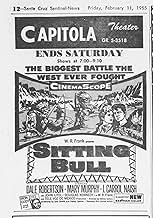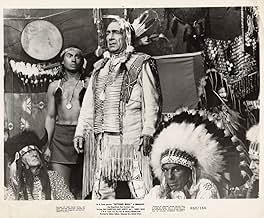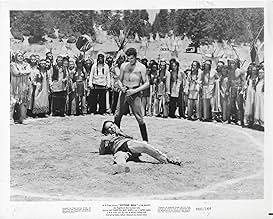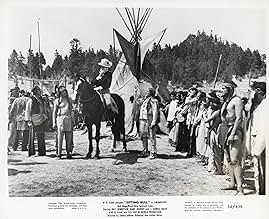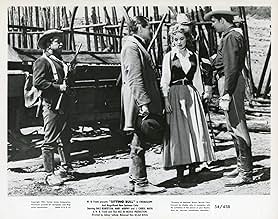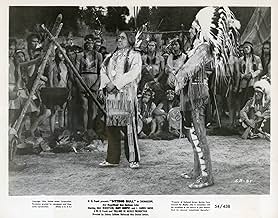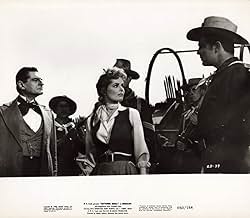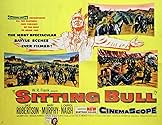A cavalry officer sympathetic to the wronged Sioux fixes a meeting between Chief Sitting Bull and President Grant but a dishonest Indian Agent and a hateful General Custer test the Sioux's p... Read allA cavalry officer sympathetic to the wronged Sioux fixes a meeting between Chief Sitting Bull and President Grant but a dishonest Indian Agent and a hateful General Custer test the Sioux's patience, threatening to derail the peace-talks.A cavalry officer sympathetic to the wronged Sioux fixes a meeting between Chief Sitting Bull and President Grant but a dishonest Indian Agent and a hateful General Custer test the Sioux's patience, threatening to derail the peace-talks.
- Charles Wentworth
- (as Bill Hopper)
- Webber - Indian Agent
- (as Tom Brown Henry)
- White Cloud
- (uncredited)
- Trooper Foster
- (uncredited)
- Young Buffalo
- (uncredited)
- Trooper
- (uncredited)
- Capt. Swain
- (uncredited)
- Director
- Writers
- All cast & crew
- Production, box office & more at IMDbPro
Featured reviews
There's a traditional romance thrown into the mix, between a General's daughter (MARY MURPHY) and Robertson, with rival suitor WILLIAM HOPPER as another man interested in Murphy. J. CARROL NAISH is Chief Sitting Bull, who wants peace and refuses to put on his war paint although some members of his tribe are anxious to fight some of the white men's injustices. DOUGLAS KENNEDY is flamboyant and seriously miscast as the yellow-haired General Custer of the 7th Cavalry.
It's handsomely produced in outdoor settings that look authentic, but the stilted dialog is handled indifferently by a lackluster cast of players. DALE ROBERTSON gives a leaden performance in the major role and he doesn't get much help from WILLIAM HOPPER or MARY MURPHY, who in real life, married Robertson after this film. Their chemistry on film fails to register and her motivations throughout are sketchy, to say the least.
A major plot development has President Grant helping Robertson when he is condemned for helping Chief Sitting Bull and there are a few other subplots before we get to the battle at Little Big Horn. Robertson's compassion for the redskins almost lands him in big trouble toward the end, until Chief Sitting Bull intercedes just before he's about to be executed for treason by a firing squad.
Good western should have been much better but is marred by dull performances and uninspired direction of Sidney Salkow. The director unwisely allowed few close-ups of his cast throughout the film, depending solely on medium shots for most of the scenes, probably because he was new at the CinemaScope process. Since most of the cast underacts considerably, this is a real drawback in the more intimate moments.
The story involves the efforts of the fictional Major Bob Parrish (Dale Robertson) and Sioux Chief Sitting Bull (J. Carroll Naish) to prevent a war between the Sioux nations and the U.S. Cavalry. On one side, Sitting Bull's chiefs led by Crazy Horse (Iron Eyes Cody) and Colonel Custer (Douglas Kennedy) on the other push their superiors into war.
The requisite love triangle involves Parrish, the General's daughter Kathy (Mary Murphy) and newspaperman Wentworth (william Hopper). Kathy turns away from Parrish when he is charged with insubordination and reduced in rank to Captain. She then becomes engaged to Wentworth.
Parrish meanwhile with the assistance of former black slave "Sam" (Joel Flueller)arranges a meeting between President U.S. Grant (John Hamilton) and Sitting Bull. However, before the meeting can take place several incidents occur and war breaks out culminating with Custer's last stand at the Little Big Horn.
J. Carroll Naish lends dignity to his portrayal of Sitting Bull. We see him as an intelligent caring and cautious leader who will stoop to war only as a last resort. In a move unusual for its time black actor Joel Flueller was cast in one of the leading roles in the film.
The battle scenes are spectacular and well staged by director Sidney Salkow. In spite of the contrived Hollywood ending, this western is a lot better than some would have you believe.
J. Carrol Naish is Sitting Bull and Dale Robertson, the cavalry man who's on the side of the Indians. Its view of history may be a little off the wall but it's a perfectly accessible 'Cowboys & Indians' picture which makes you wish it were better written and acted; the on-again-off-again love affair between Robertson and Mary Murphy is frankly embarrassing. Not a great western, then and maybe not even a good western but as Dilys might say, not a bad one either.
Did you know
- TriviaThe film was shot outside of Mexico City, and star Mary Murphy caught "Montezuma's Revenge" and was very ill throughout the six-week shoot. Most of her scenes are relatively brief, possibly because of this.
- GoofsIn many of the scenes the women are obviously men.
- Quotes
Sitting Bull: I have wanted peace. I have prayed for peace. There have been battles. But when the white soldiers win a battle, they call it victory. When the Indians win, they call it massacre.
- Crazy creditsDuring the opening titles, the film's 'Technical Advisor and Indian Costumes' is credited to 'Iron Eyes Cody' who is also parenthetically credited as being a '(Famous T.V. Star)'.
- ConnectionsFeatured in Le Massacre des Sioux (1965)
- SoundtracksGreat Spirit
Music and Lyrics by Max Rich
- How long is Sitting Bull?Powered by Alexa
Details
- Release date
- Countries of origin
- Language
- Also known as
- Sitting Bull, el indio heroico
- Filming locations
- Production companies
- See more company credits at IMDbPro
Box office
- Gross US & Canada
- $1,500,000
- Runtime
- 1h 45m(105 min)
- Sound mix
- Aspect ratio
- 2.55 : 1


